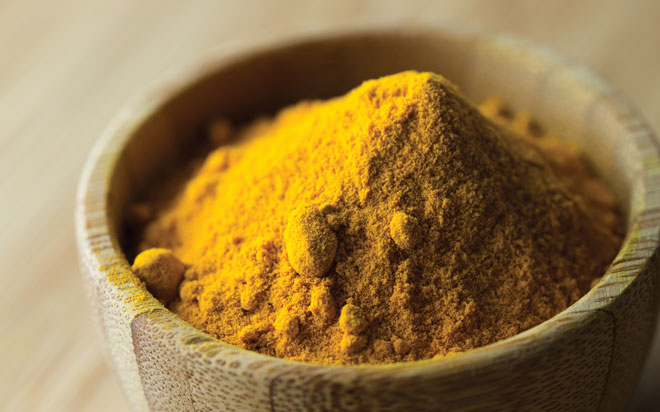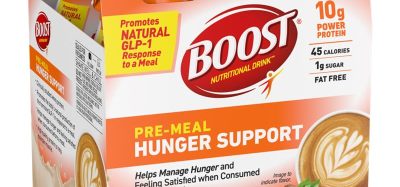The science of turmeric
- Like
- Digg
- Del
- Tumblr
- VKontakte
- Buffer
- Love This
- Odnoklassniki
- Meneame
- Blogger
- Amazon
- Yahoo Mail
- Gmail
- AOL
- Newsvine
- HackerNews
- Evernote
- MySpace
- Mail.ru
- Viadeo
- Line
- Comments
- Yummly
- SMS
- Viber
- Telegram
- Subscribe
- Skype
- Facebook Messenger
- Kakao
- LiveJournal
- Yammer
- Edgar
- Fintel
- Mix
- Instapaper
- Copy Link
Posted: 26 April 2016 | Katie Pand, Senior Herbal Advisor, Pukka Herbs | No comments yet
Turmeric is making waves at the moment and is fast becoming the remedy of choice for inflammation, pain relief, digestive disorders and much more…


Turmeric, also known as the ‘the Golden Goddess’ in India, has been used for thousands of years in Ayurvedic traditions as a medicinal herb as well as an essential ingredient in curry. Pigments known as curcuminoids give this radiant root its characteristic vibrant yellow colour. These pigments are also responsible for the primary medicinal properties of this renowned anti-inflammatory.
Curcuminoids have a diverse range of functions; primarily they work within the body as antioxidants and strong anti-inflammatories, whilst also enhancing circulation, protecting the brain, rejuvenating the liver and targeting pain.
In traditional herbal medicine turmeric is specifically used for blood health: cleaning it for healthy skin, moving it for better circulation and nourishing it to feed the menses, breast milk and bones. Its time-honoured position has made turmeric the go-to herb for addressing the underlying causes of so many of today’s degenerative diseases.
Turmeric is a member of the ginger family and shares many similarities to both ginger and galangal, demonstrable from the shape of their bulbous rhizomes (roots). The turmeric plant grows up to about 1m in height with large oblong shaped leaves and white/green flowers.
The multi-organ protector
Turmeric contains over 200 compounds which display biological activity.
- Turmeric is a superb anti-inflammatory which actively inhibits certain inflammatory pathways within the body, significantly impacting upon external and internal inflammation. This has made turmeric a first choice for inflammations of the musculoskeletal system and the digestive system.
- Research has shown that turmeric impacts upon certain pain receptors within the body. It has been demonstrated as being particularly effective for chest and abdominal pain, frozen shoulder and menstrual cramping. This, along with its strong anti-inflammatory actions, makes turmeric a fantastic remedy for inflamed, swollen and painful conditions.
- Turmeric contains some very potent antioxidants that will not only provide further anti-inflammatory protection, but also have the ability to protect cellular DNA and repair any existing cellular damage from environmental carcinogens, for example.
- Turmeric has a significant action upon the heart and the circulation. It will improve the flow of blood to the heart and encourage anti-platelet activity, reducing the risk of atherosclerosis and plaque build-up in the arteries. Turmeric also improves blood flow through the liver, improving the efficacy of liver detoxification pathways and also stimulating cellular repair mechanisms in damaged liver cells. This improvement in blood flow and quality impacts significantly upon the quality of the skin and turmeric can, therefore, be an excellent remedy for any afflictions of the skin.
- In the digestive system turmeric helps balance levels of pathogenic bacteria – helping to create a state of homeostasis – and is also an effective anti-bacterial. Along with the anti-inflammatory and stimulant effects on the blood, turmeric can be very effective in treating infectious and congested conditions of the digestive tract.
- The purifying and stimulating effect of turmeric on the blood flow makes this herb well suited to treating a congested menses and also stagnant conditions of the female reproductive system.
Turmeric feeds the microvascular bed
The microvascular bed comprises countless small arterioles, capillaries and venules. It regulates the contractile relationship between blood vessel walls and circulating blood, regulating haemostasis and is a gateway to our immune cells. Its health affects hypertension, diabetes, cholesterol, atherosclerosis, alzheimer’s, liver disease, erectile dysfunction and cancer. Because of turmeric’s fundamental ability to enhance circulation through influencing platelets and thinning the blood it serves as a key-stone species in the treatment of today’s epidemic of diseases stemming from microvascular, inflammatory and neurodegenerative disorders.
Who wants curcumin-free turmeric?
Much is known about curcumin, the strong antioxidant compound in turmeric, proven to have
anti-inflammatory, anti-microbial, anti-rheumatic, wound-healing and anti-cancer activities.
When you consider that whole turmeric contains at least 20 phytochemicals that are anti-biotic; 14 that are known cancer preventatives; 12 that are anti-tumour; 12 that are anti-inflammatory and that there are at least 10 different anti-oxidants, it makes you realise that turmeric is rather a lot more than curcumin.
Turmeric has over 200 beneficial compounds, including important compounds such as turmerones found only in essential oils (and all of Pukka’s Turmeric products). Studies have shown that curcumin cannot be absorbed without consuming compounds such as turmerones. These other extracts are rarely present unless the wholistic method is used.
As curcumin is not water soluble, this indicates that all other compounds are also able to deliver a therapeutic benefit. Recent studies indicate that curcumin-free turmeric (CFT) possesses numerous biological properties including anti-inflammatory, anticancer and antidiabetic activities. In a previously published review1 the anticancer and anti-inflammatory activities of CFT and the individual components of turmeric – including turmerin, turmerone, elemene, furanodiene, curdione, bisacurone, cyclocurcumin, calebin A and germacrone – are exhibited. Practitioners should note that this broad range of turmeric compounds are rarely present at significant levels in the solvent extracted curcumin products on the market.
Nrf2 is a protein involved in the cellular response to oxidative damage caused by injury or inflammation. It is pivotal in the regulation of various cellular processes, such as antioxidant defences, redox equilibrium, the inflammatory process, the apoptotic processes, detoxification, and cellular proliferation2 and furthermore offers a strategy for cancer chemopreventive phytochemicals3. Numerous studies have shown this Nrf2- conferred, multi-organ protection phenomenon protects many cell types and organ systems from a broad spectrum of toxic insults and disease pathogenesis4.Nrf2 moderates gene regulation and the Antioxidant Response Elements to protect neurological pathways, making it especially relevant to focus on for treating Parkinson’s, ALS and Alzheimer’s.
Studies comparing isolated curcumin extracts, standard turmeric powder and wholistic extracts show that Nrf2 activation is most potent in whole turmeric extracts (75% more effective at enhancing Nrf2 compared to an isolated curcumin product and 93% more than conventional turmeric powder). From this it can be suggested that compounds other than the curcuminoids activate the multi-organ protector and a synergistic effect may occur. These results are in line with the outcome of the antioxidative potential determined by ORAC analysis where Wholistic Turmeric extract showed outstanding activity of antioxidant scavenging compared to a combination of fresh fruits and vegetables.
Most curcumin on the market today is extracted with hexane, ethyl acetate, acetone or methanol. All have questionable environmental credentials and, as this process strips the other synergistic compounds out of the turmeric, it often requires curcumin products to then be further processed into liposomes or miscelles to have any significant absorption (as well as requiring toxicological studies in animals to prove safety).
More cutting-edge methods of extraction that combine super critical extraction (using carbon dioxide) with tincture extraction (using water and alcohol) are leading the way in capturing the holy grail of herbal extraction: concentration of the parts while still representing the whole spectrum of plant compounds. In turmeric’s case this is to capture the curcumin as well as the resinous and essential oil turmerone compounds.
Turmeric’s traditional use with black pepper, ginger, milk or ghee reveals an ancient insight into how we can enhance the bioavailabilty and efficacy of the turmeric; take your whole turmeric with spice and fat. The positive epidemiological benefits of using turmeric powder in the Indian diet (at around 1g/day) may contribute to lower cancer rates, Alzheimer’s and diabetic complications seen on the Indian subcontinent.
Some years ago Pukka Herbs set itself the challenge of finding a method of capturing all of the goodness in a plant, whilst doing it in a more energy-efficient and environmentally sound way. Pukka has achieved this with turmeric and has not only coined this method but trademarked it ‘Wholistic’ too.
Our Wholistic Turmeric is now 10 times more concentrated in curcuminoids and one and a half times more in essential oils in comparison to just turmeric root.
Pukka Herbs addition of piperine from long pepper in Turmeric Active further adds to absorption so much so that is has been shown to increase absorption by over 2000%5.
Pukka Herbs’ newly branded 100% natural, organic turmeric range; Turmeric Active, Wholistic Turmeric, Turmeric Lifekind and Active 35 oil will be available in independent health food stores from May.
References
- Aggarwal et al. (2013) Curcumin-free turmeric exhibits anti-inflammatory and anticancer activities: Identification of novel components of turmeric. Cytokine Research Laboratory, University of Texas MD Anderson Cancer Centre Houston. 57(9)
- Morales-González, et al. (2015) What is Known Regarding the Participation of Factor Nrf-2 in Liver Regeneration? Cells;4(2):169-77
- Becks L, et al. (2010) Aggressive mammary carcinoma progression in Nrf2 knockout mice treated with 7,12-dimethylbenz[a]anthracene. BMC Cancer;10:540
- Lee et al. (2005) The expression of RANTES and chemokine receptors in the brains of scrapie-infected mice.J Neuroimmunol;158:26–33
- Shoba G, et al. (1998) Influence of piperine on the pharmacokinetics of curcumin in animals and human volunteers. Planta Med 64, 353–356
About the author
Katie is a qualified Medical Herbalist, with BSc (Hons) Herbal Medicine, and a member of the National Institute of Medical Herbalists (NIMH). Katie’s decision to study herbal medicine was sparked whilst studying for a degree in plant biology in Scotland. Katie spent the summer of her 2nd year in Egypt undertaking conservation work and, unfortunately, became ill. No conventional medicines proved effective, and it was only after taking advice from the local Bedouin ‘medicine man’ that she started to recover. Katie later deduced that this miracle plant was a relative of the thyme family. It made Katie aware of how plants have the power to support whole communities by becoming sources of food, shelter and, most importantly, medicine. It was this experience that encouraged her to embark on a second degree in herbal medicine.









